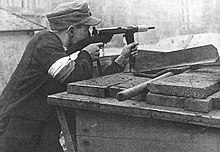Błyskawica (submachine gun)
| Blyskawica | |
|---|---|

|
|
| general information | |
| Developer / Manufacturer: | Polish Home Army |
| Manufacturer country: | Poland |
| Production time: | 1943 to 1944 |
| Weapon Category: | Submachine gun |
| Furnishing | |
| Overall length: | 556-730 mm |
| Barrel length : | 197 mm |
| Technical specifications | |
| Caliber : | 9 mm parabellum |
| Possible magazine fillings : | 32 cartridges |
| Ammunition supply : | Bar magazine |
| Cadence : | 550-650 rounds / min |
| Charging principle: | Recoil loader |
| Lists on the subject | |
Błyskawica ( Polish : Blitz) was a submachine gun that was developed and manufactured during the Second World War in German-occupied Poland by the Armia Krajowa , the largest Polish resistance movement . It was a technically successful design of a compact weapon; it was very likely the only weapon developed and mass-produced in the occupied part of Europe.
history
In 1942 the engineer Wacław Zawrotny suggested to the management of the Armia Krajowa that they develop a cheap submachine gun that they could build themselves for the Polish resistance. The main focus was on the simplicity of the construction, so that production could even be carried out in smaller workshops by inexperienced technicians. Zawrotny's idea was accepted, which is why he and Seweryn Wielanier designed a submachine gun, which was soon baptized Błyskawica . In order to ensure simple production, all individual parts of the weapon were connected with screws and threads, not with bolts and welds, as has been the norm since the beginning of firearm production in the 17th century.
The technical design was based on two of the most famous submachine guns of the era: the outer shape with a retractable metal shoulder rest and a magazine mounted under the weapon was based on the successful German submachine gun 40 . The internal structure of the mechanics was modeled on the British Sten Gun . The weapon was shooting with a mass lock . She performed well and was very reliable. In contrast to the Sten Gun and its Polish clone, it had a freely movable, i.e. not spring-loaded, firing pin .
The design work ended in April 1943 and a first prototype was available in September 1943. After extensive experiments in the woods around Zielonka near Warsaw, the weapon was presented to the commanding officer of the KeDyw , August Emil Fieldorf , who found the design acceptable. In November, the construction plans were handed over to some workshops in occupied Poland, and series production began. The name of the weapon came from the fact that the developers engraved three lightning bolts on the prototype. This logo was similar to that of the Elektrit Radiotechnical Society , which the developers had worked for before the war.
Production began in a Warsaw factory that officially manufactured metal fences. After the initial tests with five prototypes, the KeDyw ordered 1000 pieces and later another 300. By July 1944 and the start of the Burza campaign , almost 600 pieces had been produced in Warsaw. Another 40 were produced during the Warsaw Uprising . It is possible that the Błyskawica was made in small numbers outside of Warsaw.
literature
- PWN Leksykon: Wojsko, wojna, broń, Wydawnictwo Naukowe PWN , Warszawa 2001, ISBN 978-83-01-13506-5
